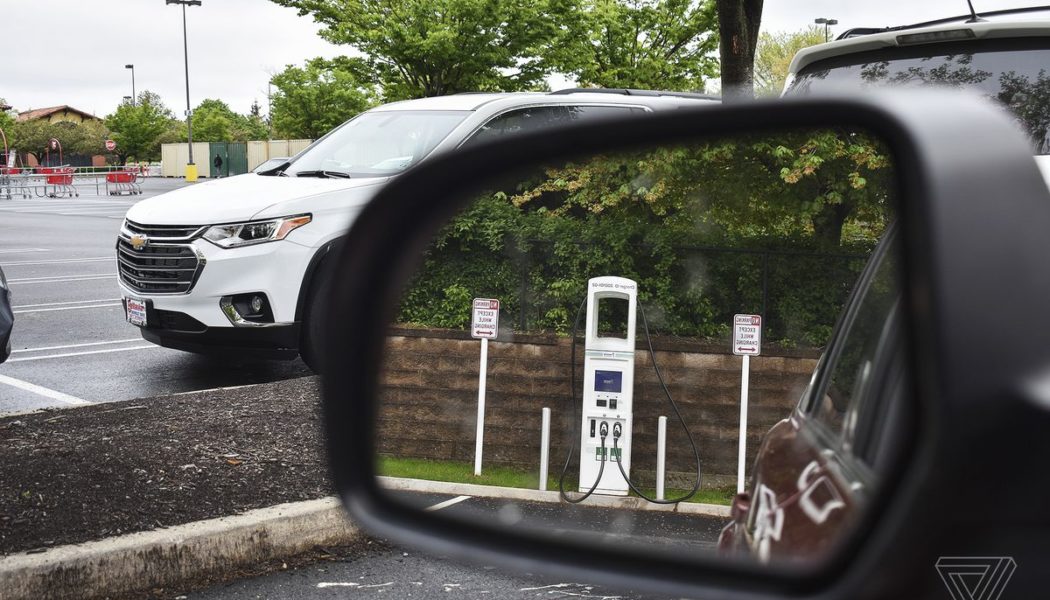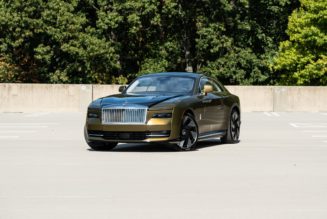Aaron Fisher first came face to face with the US’s inconvenient and broken electric vehicle charging infrastructure two years ago. Driving a borrowed BMW i3 from New York City to Hartford, Connecticut, for his grandmother’s 90th birthday party, he assumed the journey would be a short, three-hour jaunt. Instead, it lasted a grueling seven hours.
“I had charger issues, I had payment issues, I had customer service issues, I had routing issues, because of the fragmentation around electric vehicle charging,” Fisher said. As for his grandmother’s birthday? “I missed her dinner,” he said ruefully. “She was not mad, but very disappointed.”
There are approximately 41,000 public charging stations in the United States, with more than 100,000 outlets. But finding one that actually works or isn’t locked inside a gated parking garage can be a bit of a scavenger hunt. The charging experience in the US is almost comically fragmented, especially for non-Tesla owners. While Tesla’s Supercharger network has been praised for its seamless user experience and fast charging ability, the opposite appears to be true for pretty much everyone else.
Fisher, a former management consultant who also briefly interned in the Obama White House, was so frustrated by his experience trying to drive an EV in the US that he founded his own company, EVPassport, based on the principle that charging your electric vehicle should not require signing up for a dozen different smartphone apps.
“You shouldn’t have to hand over your birthday, you shouldn’t have to hand over your email address, you shouldn’t have to hand over your full name, or anything in an application or agree to any type of privacy policy necessarily, in order to charge your vehicle,” Fisher said. “You don’t have to do that when you get gas. Why do you have to do that when you’re trying to do something better?”
Fortunately, the whole system appears headed toward a massive overhaul. President Joe Biden, an avowed muscle car guy who is currently trying to claim the mantle of “most environmentally friendly president in history,” recently introduced a $2 trillion infrastructure plan, $174 billion of which is earmarked for electric cars. As part of that plan, Biden wants to build 500,000 new EV chargers by 2030 — 11 times the current number of stations.
Biden will have his work cut out for him. Despite rapid growth in sales over the past few years, EVs are still a niche product, making up just 2 percent of the new car market and 1 percent of all cars, SUVs, vans, and pickup trucks on the road. That said, sales are expected to pick up in the next few years, depending on new incentives and point-of-sale rebates that are currently being debated. But when they do, there are real questions about whether the nation’s disjointed, low-tech, outdated charging system will be up to the task.
“There’s no APIs in the charging marketplace,” Fisher said, referring to the software intermediary that allows two apps to communicate. “It’s kind of like banking in the ’90s.”
:no_upscale()/cdn.vox-cdn.com/uploads/chorus_asset/file/22498544/ahawkins_20210503_4551_0015.jpg)
The Charging Problem
On paper, the EV charging network sounds like it’s doing pretty good.
A closer look reveals how incredibly uneven it is. One-third of those stations are located in one state: California, with a whopping 22,620 stations, according to a recent study by Pew Trust. Other states have few, bordering on none. North Dakota has 36 public chargers, Alaska just 26.
But don’t mistake California as some sort of bastion of enlightened EV ownership. A recent study published in Nature Energy by a research team from the University of California, Davis found that about 1 in 5 EV owners — 20 percent of plug-in hybrid vehicle owners and 18 percent of pure battery-electric vehicle owners — eventually switched back to gas-powered vehicles. The top reason cited was “dissatisfaction with the convenience of charging.”
This shouldn’t come as a surprise. “Range anxiety,” or the fear of running out of power before finding the next charging station, has long been cited as a major barrier to mass EV adoption. But while range has steadily improved over the years, with many EVs now able to travel 300 miles or more on a single charge, the anxiety has shifted to the inadequacies of the charging network.
Chargers can be hard to find, and the act of charging takes much longer than refueling a gas car. The research team at UC Davis noted this in their study. “The way in which a [plug-in electric vehicle] is charged has not changed, whereas vehicle range has been increasing since [plug-in hybrid electric vehicles] and [battery-electric vehicles] were introduced,” they conclude. Electric vehicle owners “have the option to purchase longer-range vehicles, whereas they cannot yet purchase a vehicle that is charged differently.”
EV boosters say that much of the problem stems from a faulty frame of reference. We see how many gas stations are available — around 150,000 by some estimates — and believe that the same should be true for chargers if EVs are ever to replace their gas-powered counterparts.
This ignores the fact that most EV owners do their charging overnight while parked in their driveway at home. But if EVs are to become a more attractive option to car buyers, charging stations are going to need to become more pervasive like gas stations. People need to see the expansion with their own eyes in order to overcome the psychological hurdle that prevents them from imagining an electric future.
:no_upscale()/cdn.vox-cdn.com/uploads/chorus_asset/file/22498507/akrales_20210504_4551_0082.jpg)
:no_upscale()/cdn.vox-cdn.com/uploads/chorus_asset/file/22498502/akrales_20210504_4551_0053.jpg)
:no_upscale()/cdn.vox-cdn.com/uploads/chorus_asset/file/22498496/akrales_20210426_4551_0004.jpg)
:no_upscale()/cdn.vox-cdn.com/uploads/chorus_asset/file/22498498/akrales_20210426_4551_0032.jpg)
There are educational obstacles, too. The way car companies communicate the amount of time it takes to charge an EV completely misses the point, said Chris Nelder, manager of Carbon-Free Mobility at the Rocky Mountain Institute. Automakers avoid talking about kilowatts and kilowatt-hours, instead relying on the nonsense metric of miles-per-minute of charging.
“We all understand this when it comes to gasoline,” Nelder said. “We all know what a gallon is. We all know how many gallons of gas our tanks can hold. We all know how many miles per gallon our vehicles get. But for some reason everybody operating in this space is afraid to explain to a customer what the equivalent is on the electric side.”
This is one of the educational hurdles that the Biden administration will confront in its quest to get more people in EVs. But it’s not clear the administration is focused on education, so much as incentivizing the purchase of more EVs through tax credits, point-of-sale rebates, and direct subsidies to automakers.
Money, the policymakers have determined, will be the thing to spur this shift.
The Money Problem
The White House has said it will spend at least $15 billion to begin rolling out the new charging stations. But experts say far more will be needed to shore up charging infrastructure to meet the growing demands of EV ownership.
Wedbush Securities has estimated that at least $60 billion will be needed to build 500,000 chargers by the end of 2030, as Biden has stated. Another analysis by industry consultant AlixPartners said $50 billion would be needed to grow the US charging network to meet the demand within the next decade. That means Biden will need at least $35 billion more, either from private investments or state and local government matching funds, if he is to meet his goal.
Installing EV chargers can be expensive, depending on the level of charging that’s being offered. The higher the level, the quicker the charge and the more expensive it is to install. A public Level 2 charger might cost $2,000 out of the box, but a DC fast charger of 150kW or more can cost between $100,000 and $250,000, Nelder said.
The federal government could intervene in making those costs cheaper, but it won’t be easy. That would require sitting down with utility companies and regulatory commissions in all 50 states, as well as the private EV charging companies, to bring down the capital investments for charging stations through “make ready” programs. These are programs in which public utilities and local governments identify sites that are intended for EV charging and allow companies to submit bids for installation. There is no federal “make ready” program, though, and only a few states employ this method of fast-tracking EV charger installation. The Biden administration could make things a lot easier by creating a national system for states to use.
:no_upscale()/cdn.vox-cdn.com/uploads/chorus_asset/file/22498539/ahawkins_20210503_4551_0002.jpg)
Another looming problem is utilization and how utilities charge for the electricity they provide. Most EV charging stations sit unoccupied because EVs still only make up a tiny fraction of the overall car market. That means the business case for building more chargers is very difficult to make.
“It’s that first few years where you want me to put a quarter million into a station, and then I can’t get better than 5 percent utilization,” said Henry Lee, director of the Harvard Kennedy School’s environmental and natural resource program. “I lose my shirt in the first three or four years, but by year seven or eight, I could be making money on it.”
Lee noted that the cost of electricity is another problem for EV charging companies. Demand charges from utility companies tend to dominate charging companies’ operating costs, further complicating the business case for building more charging stations. The total cost of electricity is higher based on the level of charging they provide. These calculations need to be rethought if the government wants to incentivize the EV charging industry.
“How you restructure this formula for these kinds of stations is something that we haven’t quite figured out,” Lee said.
The Tesla Problem
Tesla’s Supercharger network is often held up as the best possible example of an EV charging network: fast, reliable, and plentiful. But Tesla’s network is also exclusive to Tesla owners, meaning someone driving a Volkswagen EV wouldn’t be able to use it.
Other EV companies have expressed interest in a proprietary system. Rivian, backed by Ford and Amazon, said recently it would build its own network of 3,500 fast chargers at 600 locations around the country by 2023.
These kinds of close systems are worrisome if more car companies decide they want their own networks. But Nelder said that two automakers building their own exclusive charging networks isn’t necessarily an indication of where things are headed for EV charging. First of all, Nelder said that Rivian’s goal of 3,500 fast chargers in two years was almost impossible, given the intense and expensive amount of work that each site requires.
“I literally laughed out loud,” he said.
But even then, Nelder said he hopes that the Biden administration is strict about what kind of charging projects are eligible for public money. “To whatever extent public money is being spent, it should only be spent on sites that are available to the public,” he said, “and that’s certainly true for this Biden infrastructure spending plan.”
Ideally, more electric vehicles will include the Plug and Charge standard that was initially introduced by ISO 15118. This standard enables an EV to automatically identify and authorize itself to a charging station on behalf of the driver. For example, when it goes on sale in the US later this year, the Mercedes-Benz EQS will be compatible with about 90 percent of the public charging stations in the US without the need to download an app or sign up for an individual charging service, thanks to the Plug and Charge system.
But there are many EVs coming onto the market without Plug and Charge, such as the Volkswagen ID 4 and Chevy Bolt EUV, and it’s unclear why. This is another source of frustration and confusion for Aaron Fisher of EVPassport. It’s a sign that for all the good news on the horizon, the EV charging infrastructure in the US will remain opaque and challenging for months, if not years to come.
“It feels like they’re missing some very core decisions at a high level,” Fisher said of the auto industry. “I don’t know if it’s a lack of planning, or just they’re trying to focus on cars and getting them out the door.”










